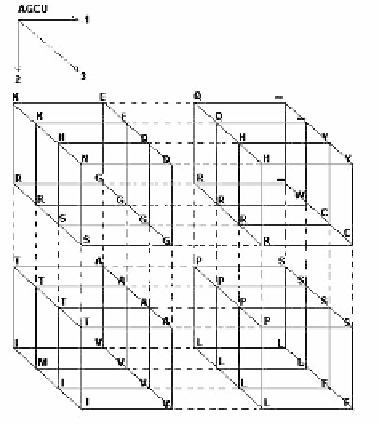Information Technology Reference
In-Depth Information
Diagram A Diagram B
Figure 1.
Diagrams of semihomologous relations among amino acids (Diagram A)
and their codons (Diagram B). The codons of residues along each axis differ by only
one nucleotide. The diagram setting shows the codon changes at first (axis 1),
second (axis 2) or third (axis 3) position in order: AĺGĺCĺU. Those diagrams
form the basis of the non-statistic genetic senmihomology algorithm. Full lines mean
transitions, dashed lines - transversions.
A single nucleotide replacement concerns three types of mutations: transition -
within the same group (purine to purine or pyrimidine to pyrimidine), transversion -
between two groups (purine to pyrimidine or conversely) and cryptic mutation -
replacement one nucleotide by another within the trird residue of the codon, without
changing it's sense. This mutation type and the presence of six-codon amino acids
determine a better variety of proteins. The cryptic mutation process itself isn't subjected to
selection, but it increases the spectrum of amino acid diversity. That is why serine is able to
replace 12 different amino acid residues (including a cryptic mutation) - two times more
frequently than methionine (one codon). This is a proof why six-codon amino acids play a
crucial role in increasing the field of diversity in occupied positions (especially serine).
The algorithm of genetic semihomology breaks the rule of using the Markov model
as a tool for comparing two protein sequences. Opposite to this model, the algorithm
predicts the amino acid residue occupying this position in the future with taking into
consideration the fact, what kind of residue was occupying this position in the past. The
algorithm of genetic semihomology assumes close relations among amino acids residues
and their codons; the same residues in different positions in the respect of their ability to a
substitution are not equal. It treats every amino acid residue as individuality, taking into
consideration what kind of amino acid occurred the position in the past. It is based on a
theory, not statistics. Its sense is the minimalisation of assumptions and the influence of the
user to the analytic process.


